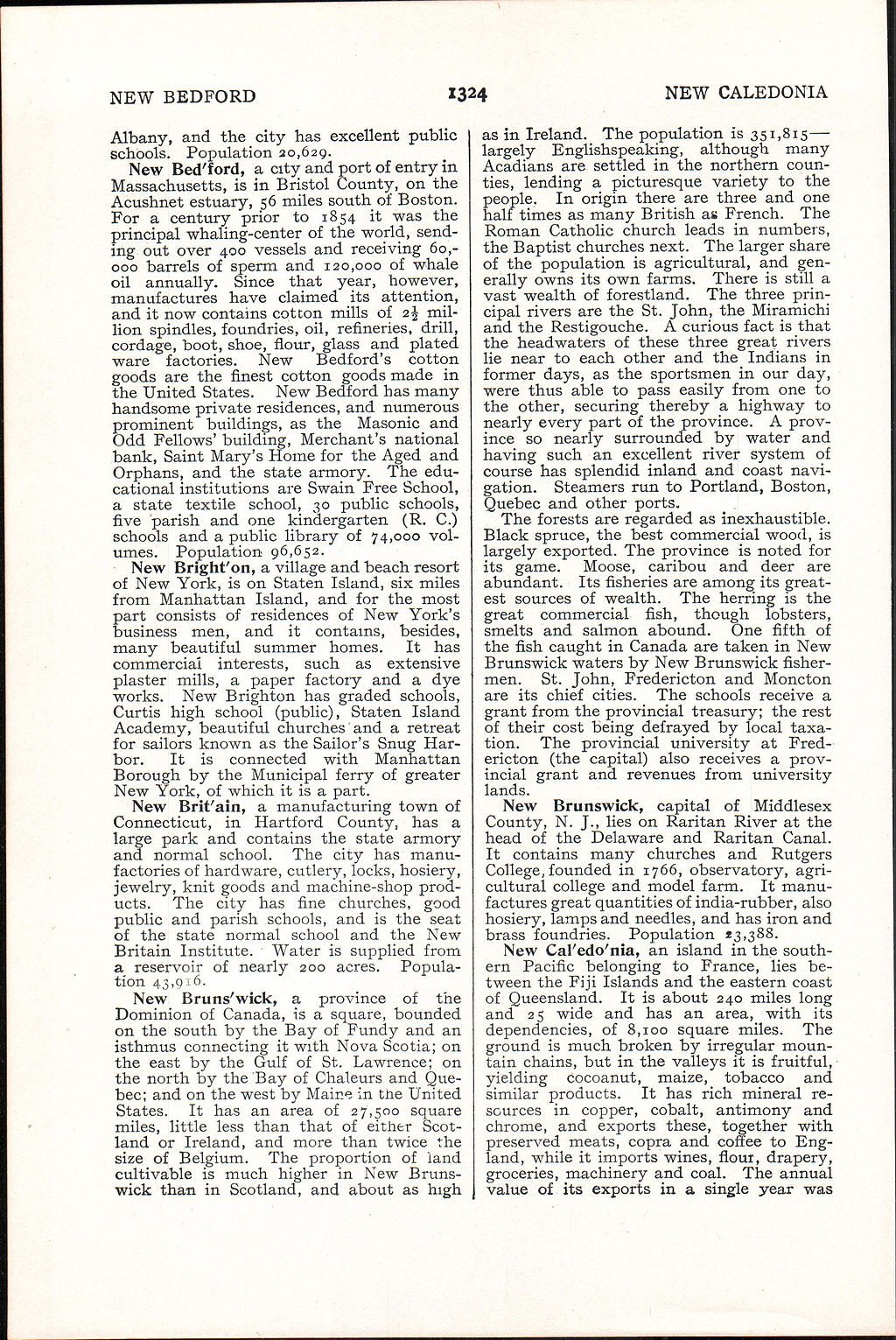NEW BEDFORD
1324
NEW CALEDONIA
Albany, and the city has excellent public schools. Population 20,629.
New Bed'ford, a city and port of entry in Massachusetts, is in Bristol County, on the Acushnet estuary, 56 miles south of Boston. For a century prior to 1854 it was the principal whaling-center of the world, sending out over 400 vessels and receiving 60,-ooo barrels of sperm and 120,000 of whale oil annually. Since that year, however, manufactures have claimed its attention, and it now contains cotton mills of 2j million spindles, foundries, oil, refineries, drill, cordage, boot, shoe, flour, glass and plated ware factories. New Bedford's cotton goods are the finest cotton goods made in the United States. New Bedford has many handsome private residences, and numerous prominent buildings, as the Masonic and Odd Fellows' building, Merchant's national bank, Saint Mary's Home for the Aged and Orphans, and the state armory. The educational institutions are Swain Free School, a state textile school, 30 public schools, five parish and one kindergarten (R. C.) schools and a public library of 74,000 volumes. Population 96,652.
New Brighton, a village and beach resort of New York, is on Staten Island, six miles from Manhattan Island, and for the most part consists of residences of New York's business men, and it contains, besides, many beautiful summer homes. It has commercial interests, such as extensive plaster mills, a paper factory and a dye works. New Brighton has graded schools, Curtis high school (public), Staten Island Academy, beautiful churches and a retreat for sailors known as the Sailor's Snug Harbor. It is connected with Manhattan Borough by the Municipal ferry of greater New York, of which it is a part.
New Brit'ain, a manufacturing town of Connecticut, in Hartford County, has a large park and contains the state armory and normal school. The city has manufactories of hardware, cutlery, locks, hosiery, jewelry, knit goods and machine-shop products. The city has fine churches, good public and parish schools, and is the seat of the state normal school and the New Britain Institute. Water is supplied from a reservoir of nearly 200 acres. Population 43,9.1 6.
New Bruns'wick, a province of the Dominion of Canada, is a square, bounded on the south by the Bay of Pundy and an isthmus connecting it with Nova Scotia; on the east by the Gulf of St. Lawrence; on the north by the Bay of Chaleurs and Quebec; and on the west by Maine in the United States. It has an area of 27,500 square miles, little less than that of either Scotland or Ireland, and more than twice the size of Belgium. The proportion of land cultivable is much higher in New Brunswick than in Scotland, and about as high
as in Ireland. The population is 351,815— largely Englishspeaking, although many Acadians are settled in the northern counties, lending a picturesque variety to the people. In origin there are three and one half times as many British as French. The Roman Catholic church leads in numbers, the Baptist churches next. The larger share of the population is agricultural, and generally owns its own farms. There is still a vast wealth of forestland. The three principal rivers are the St. John, the Miramichi and the Restigouche. A curious fact is that the headwaters of these three great rivers lie near to each other and the Indians in former days, as the sportsmen in our day, were thus able to pass easily from one to the other, securing thereby a highway to nearly every part of the province. A province so nearly surrounded by water and having such an excellent river system of course has splendid inland and coast navi-
eition. Steamers run to Portland, Boston, uebec and other ports.
The forests are regarded as inexhaustible. Black spruce, the best commercial wood, is largely exported. The province is noted for its game. Moose, caribou and deer are abundant. Its fisheries are among its greatest sources of wealth. The herring is the great commercial fish, though lobsters, smelts and salmon abound. One fifth of the fish caught in Canada are taken in New Brunswick waters by New Brunswick fishermen. St. John, Fredericton and Moncton are its chief cities. The schools receive a grant from the provincial treasury; the rest of their cost being defrayed by local taxation. The provincial university at Fredericton (the capital) also receives a provincial grant and revenues from university lands.
New Brunswick, capital of Middlesex County, N. J., lies on Raritan River at the head of the Delaware and Raritan Canal. It contains many churches and Rutgers College, founded in 1766, observatory, agricultural college and model farm. It manufactures great quantities of india-rubber, also hosiery, lamps and needles, and has iron and brass foundries. Population 23,388.
New Cal'edo'nia, an island in the southern Pacific belonging to France, lies between the Fiji Islands and the eastern coast of Queensland. It is about 240 miles long and 25 wide and has an area, with its dependencies, of 8,100 square miles. The ground is much broken by irregular mountain chains, but in the valleys it is fruitful, yielding cocoanut, maize, tobacco and similar products. It has rich mineral resources in copper, cobalt, antimony and chrome, and exports these, together with preserved meats, copra and coffee to England, while it imports wines, flour, drapery, groceries, machinery and coal. The annual value of its exports in a single year was
